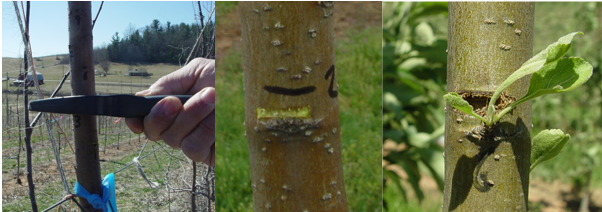Minimizing Blind Wood on Apple
go.ncsu.edu/readext?664129
en Español / em Português
El inglés es el idioma de control de esta página. En la medida en que haya algún conflicto entre la traducción al inglés y la traducción, el inglés prevalece.
Al hacer clic en el enlace de traducción se activa un servicio de traducción gratuito para convertir la página al español. Al igual que con cualquier traducción por Internet, la conversión no es sensible al contexto y puede que no traduzca el texto en su significado original. NC State Extension no garantiza la exactitud del texto traducido. Por favor, tenga en cuenta que algunas aplicaciones y/o servicios pueden no funcionar como se espera cuando se traducen.
Português
Inglês é o idioma de controle desta página. Na medida que haja algum conflito entre o texto original em Inglês e a tradução, o Inglês prevalece.
Ao clicar no link de tradução, um serviço gratuito de tradução será ativado para converter a página para o Português. Como em qualquer tradução pela internet, a conversão não é sensivel ao contexto e pode não ocorrer a tradução para o significado orginal. O serviço de Extensão da Carolina do Norte (NC State Extension) não garante a exatidão do texto traduzido. Por favor, observe que algumas funções ou serviços podem não funcionar como esperado após a tradução.
English
English is the controlling language of this page. To the extent there is any conflict between the English text and the translation, English controls.
Clicking on the translation link activates a free translation service to convert the page to Spanish. As with any Internet translation, the conversion is not context-sensitive and may not translate the text to its original meaning. NC State Extension does not guarantee the accuracy of the translated text. Please note that some applications and/or services may not function as expected when translated.
Collapse ▲Bud break has been observed across multiple apple cultivars in Western NC. Several treatments to increase lateral branching on young apple trees are effective at this time. Below are suggestions for stimulating lateral branching on one and two-year-old wood.
Stimulating lateral branching on young trees: one-year-old wood
Application of 6-benzyladenine based compounds (MaxCel®; Exilis® Plus; Exilis® 9.5 SC, etc.) to one-year-old wood can increase branching in young apple trees when applied after bud-break. Methods of application can range widely, including spray application or more directed applications with a brush, roller, sponge, etc. A rate of 500 ppm has been effective in promoting branching on one-year-old wood (see Table 1 for rates).
Table 1. Product Rates for 500 ppm 6-BA*.
| Mix Size (water volume) | MaxCel® (1.9% 6-BA) | Exilis® 9.5 SC (9.5% 6-BA) |
| 1 gallon | 3.2 fl. oz. | 0.64 fl. oz. |
| 50 gallons | 160 fl. oz. | 32 fl. oz. |
*Do not add surfactant, tank mix with streptomycin, or use streptomycin on the same day. “Built-in” surfactant in MaxCel and Exilis can increase yellowing of the leaf margin when used at high rates to induce branching.
There are several alternative timings and applications strategies for inducing lateral branches on young trees. This fact-sheet from the University of Massachusetts is an excellent resource.
Stimulating lateral branching on young trees: two-year-old wood
Inducing lateral bud break on two-year-old blind wood requires a combination of cultural and chemical practices. Notching followed by a spray application of 6-BA at 500 ppm is effective in increasing lateral bud break on 2-year-old-wood of young apple trees (~70% success rate, best case scenario). Notching is imposed with a double-bladed hacksaw and a narrow strip of bark is removed (~4 mm) just above latent buds located on blind wood of the trunk (Figure 1). Immediately after notching, 500 ppm 6-BA is sprayed directly into the notch with a squirt bottle or backpack sprayer.

Figure 1. The combination of notching latent buds and targeted application of 500 ppm 6-BA is an effective measure to induce branching on two-year-old blind wood. Photos by Dr. Steve McArtney and J.D. Obermiller.
After shoots have developed from treated areas, a targeted application of 6-BA + GA4+7 (Promalin®, Perlan®, etc.) can increase shoot length and potentially increase bearing surface. This application occurs when shoots are ~ 1-2 inches long at a rate of 250 to 500 ppm. **CAUTION** Do not impose notching/scoring treatments when conditions are conducive to fire blight infection. Notching may create sites for infection.



